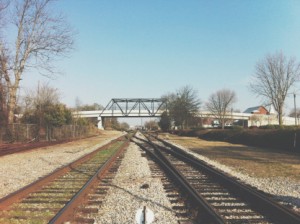Running Segregation: Prolonged Residential Segregation in America
“Blair, if you keep running over there, someone is going to hurt you! It’s so unsafe,” or even better, “Your dad got jumped over there when he was your age. What are you thinking?” I usually hear similar comments when I run anywhere near the train tracks because they’re on “that” side of town. It’s the area laced with crime and poverty, and the home to many of the African Americans in Griffin, Georgia. “That” side of town attended the poorer schools where my school did community service. “That” side of town gave the white privileged kids a thrilling drive on a weekend night. In 2016, how can “that” side of town still elicit wonder and excitement in middle class teenagers?
Not only in Griffin, but cities and small towns all over America still support separate and unequal African American communities produced by a long history of unfair policy and current day dog whistle politics. The evolution of discrimination began with slavery and prevailed through the Civil Rights Movement to ensure segregation at all cost. A New Deal program, the Federal Housing Administration, provided loans for Americans in “residentially safe zones.” These zones excluded inner city areas through a process called Redlining. As African American’s migrated to the cities after World War II, methods such as “contract-buying” and “block-busting” encouraged white people to leave the cities further creating suburbia. This was commonly known as the “white flight“.
Policy, influenced by President Johnson and Senator Mondale, attempted to solve the issue by implementing the Fair Housing Act of 1968. However, Republican President Richard Nixon led the government in a different direction. During the 1960’s, there was a party realignment caused by the Civil Rights Movement and its counterargument, which was the reaction from the white segregationists. The “solid south” left the Democratic Party to join the Republican Party. The switch to the Republican Party led Nixon to “distance himself from the civil rights voters and remind voters of the close connection between the blacks and the Democratic Party,” (McAdam et al. 111). Nixon believed “federal law requires only nondiscrimination in housing based on race, color national origin, sex and religion,” further promoting segregation by not supporting integration.
The new Republican Party relied on the “Southern Strategy”, which is currently known as “dog whistle politics”. The Republican Party used the political environment to turn white voters against the Democratic Party based on the idea that “this isn’t about helping [the white people]. This is about helping them, undeserving, lazy minorities,” (Lopez). Convincing the white majority of their need for protection against threats posed by black people, the Republican Party gained support. After realizing the loyalty of the minority vote, the Democratic Party embraced dog whistling. But, as long as the Republican Party had any power, there would be no push for racial integration.
What’s happened since 1970? Reviewing trends throughout the last forty years, segregation and isolation declined for African Americans. However, racial segregation and isolation increased for Hispanics. Clearly, we are far from full integration.
Welfare queens to gang bangers to Obama Care; our nation still uses dog whistle politics. When asked how to mend racial tensions in America, Trump emphasized law and order because “we have a situation where we have our inner cities, African-Americans, Hispanics, are living in hell because it’s so dangerous. You walk down the street and get shot.” He proceeded to blame it on “gangs roaming the streets”, which warrants stop-and-frisk procedures to protect our nation’s citizens. Rather than suggesting measures remotely promoting equality, Trump suggests a procedure rooted in racial profiling.
Since the 1960’s realignment, the Republican Party has attacked minorities through coded language/appeals. Until we realize the very real effects of this dog whistling, “that” part of town will still exist. Griffin will remain two separate communities divided by train tracks and my running routes will still be questionable to some. In 2016, the failure of our previous “efforts” is obvious. It’s time to move towards change. But how can we move forward if no one is moving at all?
